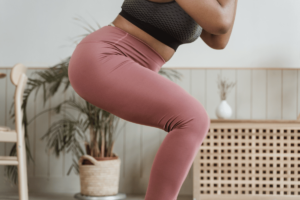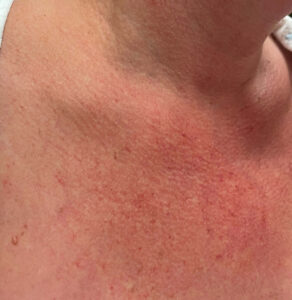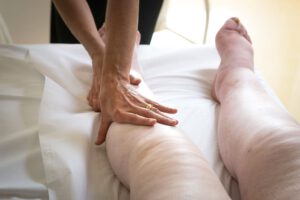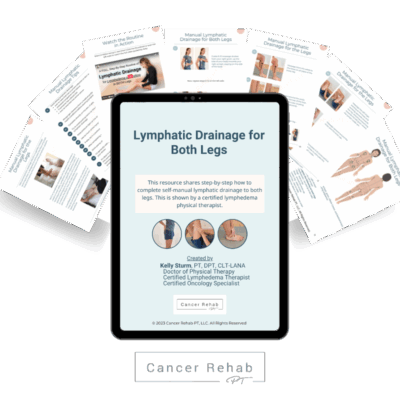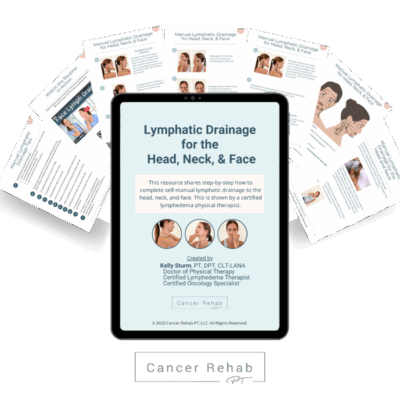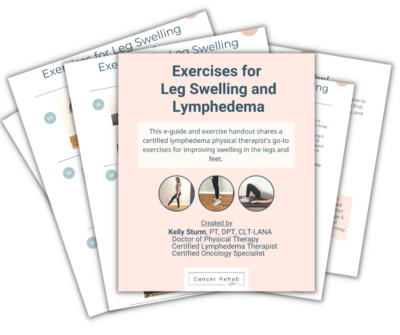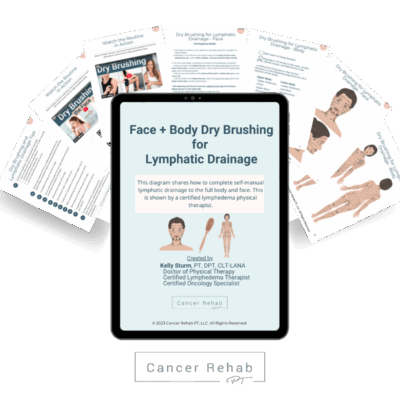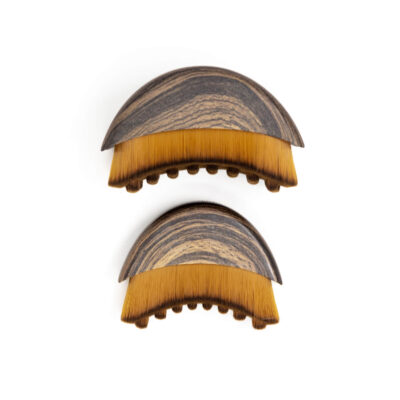Dry brushing is a popular health & wellness practice that uses a natural-bristle brush to massage your skin. Dry brushing benefits are suggested to include less swelling, better exfoliation, and cellulite reduction. It can improve your lymphatic drainage and give your lymphatic system a boost.
Many people use dry brushing for its aesthetic benefits. As a certified lymphatic specialist, I also recommend it as a self-care tool when living with lymphedema, or chronic swelling.
While dry brushing can be a beneficial self-care practice, it’s important to consult with your healthcare provider before starting any new wellness routine, especially if you have existing health conditions.
What Is Dry Brushing?
Dry brushing is a practice of using a natural-bristle brush to gently massage your skin in specific patterns. It uses firm but comfortable pressure to stimulate the skin’s surface and the lymphatic vessels that lie just underneath.
It’s an ancient practice, but it’s gained a lot of attention in the modern health & wellness space, appearing in publications like Vogue and trending across social media platforms.
Although there have been few scientific studies to support the benefits of dry brushing, many people swear by it.
As a certified lymphatic specialist and a lymphedema therapist, many of my patients tell me they have found dry brushing to be a helpful tool in their lymphedema self-care toolbox. It can be very helpful when you live with chronic swelling, whether it’s in your arms, legs, or face, as long as it’s done safely.
What Are the Benefits of Dry Brushing?
While there isn’t extensive scientific research on dry brushing specifically, the underlying principles are based on lymphatic drainage techniques used in clinical practice. There’s plenty of anecdotal evidence supporting its benefits.
In my practice as a lymphatic specialist, I’ve seen many physical therapy patients use dry brushing successfully to manage swelling and support their lymphatic health.
Here are the main benefits people experience:
Less Swelling
Dry brushing can be used as a form of lymphatic massage, and it can help reduce swelling by stimulating your lymphatic system.
The lymphatic vessels sit right under your skin, and the gentle pressure from brushing is used to encourage lymphatic fluid to move more efficiently. This is especially helpful if you have lymphedema or notice swelling in your arms, legs, or face at the end of the day.
This approach is consistent with manual lymphatic drainage techniques that certified lymphedema therapists use.
If you struggle with chronic swelling, other routines that can be helpful are doing a rebounder workout or using a vibration plate for lymphatic drainage.
Better Exfoliation
Dry brushing can be a good addition to your full-body skincare routine, especially if your skin tends to look dull or rough.
The natural bristles of a dry brush work as a gentle exfoliant, removing dead skin cells from the surface of your skin. This leaves your freshly exfoliated skin feeling smoother and looking brighter.
I have found that dry brushes are not created equal, and some may be too harsh for the skin. It’s important to avoid brushing too hard to avoid skin breakdown or irritation.
Reduced Cellulite Appearance
Dry brushing won’t permanently remove cellulite, but it can improve how your skin looks by boosting blood flow to the area. This can reduce the appearance of cellulite and make your skin smoother and plumper for a short period of time. Regular dry brushing may help maintain smoother-looking skin.
Since dry brushing works as a form of lymphatic massage, it might offer some of the same benefits. Some small studies have looked at lymphatic massage for cellulite with positive results, but the research is limited.
Improved Blood Flow
The brushing motion stimulates blood circulation near the surface of your skin. Better circulation means more oxygen and nutrients reach your skin cells, which can improve your skin’s overall health and appearance.
You might notice that your skin has a healthy glow after dry brushing.
Self-Care Ritual
Dry brushing can become a calming part of your daily routine. Many people do it before taking a shower to relax and check in with their body. In addition to the health benefits, practicing dry brushing can often simply feel nice.
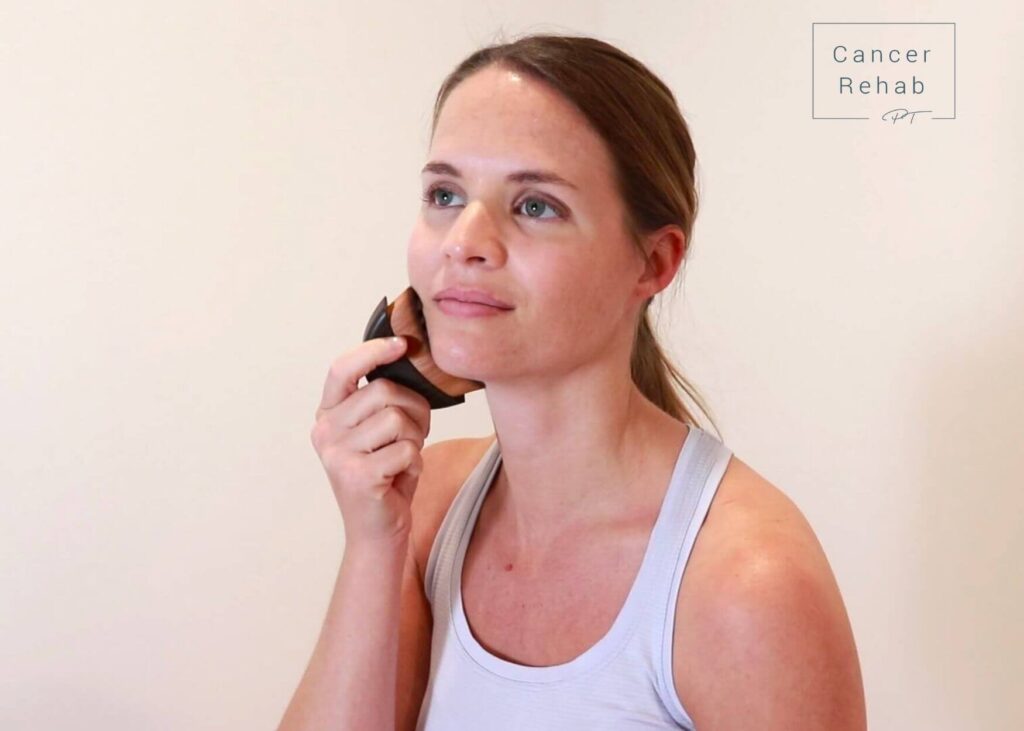
When Should You Avoid Dry Brushing?
Dry brushing is rarely risky. However, you should avoid it if you have skin conditions like eczema or psoriasis, open wounds or cuts, infections, or very sensitive skin. The brushing can irritate these conditions and make them worse.
If your skin looks red or irritated after dry brushing, it’s better to stop the practice and ask your doctor if it’s okay for you to continue. Sometimes, if you have very sensitive skin, it’s better to use a softer brush or a washcloth instead of a stiff-bristled brush.
Learn more about the dangers of lymphatic massage.
How to Dry Brush
Use a natural fiber brush in long, fluid strokes. A long handle can be helpful to reach different parts of your body, but you can also use a dry body brush with a short handle if that’s more comfortable.
Here are some things to keep in mind:
- Keep your skin dry with no lotions or oils.
- Use firm pressure that feels good without irritating your skin.
- Brush using broad, circular motions.
- Avoid brushing on very sensitive areas.
- Brush toward your lymph nodes, not your heart.
- If you’ve had lymph node surgery, brush toward your remaining healthy lymph nodes.
- Spend 3 to 20 minutes, depending on how thorough you want to be. You can do your whole body or focus on specific areas.
- Shower afterward to wash away dead skin cells.
- Apply moisturizer to clean, dry skin when you’re done.
One of the biggest mistakes I see is people dry brushing toward their heart because that’s what most tutorials recommend.
But it’s better to brush away from your heart and toward your armpit or groin.
The deeper lymphatic nodes & vessels do go to your heart, but dry brushing affects the surface ones that sit in your armpits and groin. So it makes more sense to move fluid toward those lymph nodes than the ones closer to your heart.
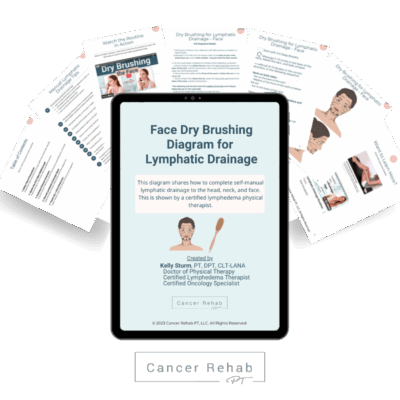
Dry Brushing to the Neck and Face for a Healthy Lymphatic System – Digital
How Many Times a Week Should I Dry Brush?
You can dry brush daily if you find it helpful, or as often as needed. I often recommend doing it in the morning or at night before you shower, since it’s an easy way to incorporate the practice into your routine, even if you’re busy. You just need to plan for an extra 5-10 minutes.
What Kind of Brush Is Best for Dry Brushing?
Look for a natural, soft-bristle brush made from quality materials. Many inexpensive options under $10 can work well. The bristles should be firm enough to exfoliate, but make sure they don’t scratch or irritate your skin.
A long handle helps reach your back and other areas, but a short-handled brush works fine too if you’re focusing on your arms, legs, or face.
If dry brushing is too irritating for your skin, a much softer option is the Lymphatic Brush.
FAQs
Does dry brushing help with cellulite?
Yes, dry brushing can help reduce the appearance of cellulite and dimpled skin by boosting circulation and making your skin look smoother and more plump for a short period of time. It doesn’t cure cellulite or make it go away permanently, but regular dry brushing may help maintain better-looking skin texture over time.
Is it better to dry brush your body at night or in the morning?
It doesn’t really matter when you dry brush. What’s more important is that you pick a time that works for your schedule so you can stick to the practice long-term.
Many of my physical therapy patients do it in the morning because it feels like a nice way to start their day and fits well with their morning shower. Others prefer to do it in the evening as a part of their wind-down ritual.
Do you dry brush towards or away from the heart?
Most tutorials tell you to brush toward your heart, but when we consider lymphatic anatomy, it makes more sense to brush toward the lymph nodes in your armpits or groin. While there are deeper lymph nodes located closer to your heart, dry brushing affects the ones right under the surface of your skin. Those lymph nodes are located in your armpits and groin.
If you have compromised lymph nodes in one armpit (for example, as a result of surgery), then brush toward the healthy lymph nodes in your other armpit.
Do you dry brush your face?
Yes, you can dry brush your face. It can be a great way to reduce swelling, either in the morning or at night. However, consider using a softer brush or even a dry washcloth because the skin on your face is more delicate than on the rest of your body.
How long does it take to see the effects of dry brushing?
You might notice that you have smoother skin, improved complexion, and less swelling right after dry brushing. These results aren’t permanent, but you can maintain them with regular dry brushing.
Final Thoughts on Dry Brushing Benefits
Even though there aren’t many medical studies on the benefits of dry brushing, it’s worth trying if you want to improve the appearance of your skin, as long as it’s safe for you!
Lymphatic drainage dry brushing is especially helpful for chronic swelling or as a self-care routine when living with lymphedema.
You can find dry brushing & lymphatic drainage step-by-step guides in my Shop!

